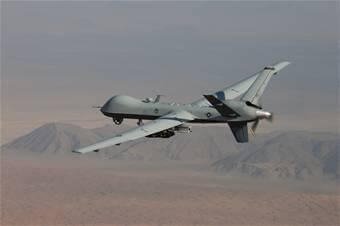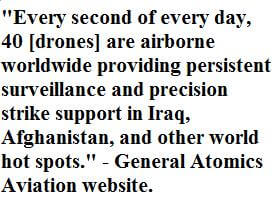
War is not a video game…but it’s starting to look more and more like one. The prevalence of unmanned aerial vehicles in the US military has changed the landscape of war forever, and no UAV demonstrates that more clearly than the MQ-9 Reaper. Born from the Predator drones that have spied on and targeted terrorists and insurgents in Afghanistan and Iraq, the MQ-9 Reaper represents the next step in remote plane technology. And that step is rigged to explode. The Reaper carries more ordinance than any other unmanned vehicle in the air, 3000+ lbs of explosives, or 14 Hellfire missiles. Standard Predators carry 2 or less. Each of these missiles are capable of taking out anything from snipers to tanks. The MQ-9 is the modern hunter-killer, made all the more remarkable because its pilots fly the UAVs in utter safety from Creech Air Force Base in Nevada. When people ask me about the future of war I point to the Reaper. Unmanned, heavily armed, covered in surveillance equipment – it’s able to spy or strike anywhere in the world. Watch the MQ-9 demonstrate its prowess in the videos below. Drones have already changed the shape of war; the next generation of UAVs like the Reaper may make it unrecognizable.
The Predator series of drones, including the MQ-9 Reaper, have been an integral part of the recent wars in the Middle East. Earlier this spring, these UAVs hit a historic milestone: 1,000,000 hours in the air. One million. That’s 80,000+ missions, 80% of which were flown in combat situations. Sometimes Predators and Reapers are just eyes in the sky, scouting terrain, and finding targets. More and more, however, these drones are delivering air to ground missiles to hostile targets. Since 2005, the US Air Force has been phasing out F-16 fighter jets (just a dozen or so at a time) and replacing them with Predator series drones. These new hunter-killers are one of the clearest examples of US military superiority to Taliban and other military forces in the region. The drones have become so recognizable that they’re starting to be included in recruiting and promotional videos used by the military, as seen with the prominence of the Reaper in this clip:
Surely one of the greatest changes the Reaper and its Predator siblings represent is the removal of soldiers from the battlefield. While Reapers can fly autonomously, most missions see them operated by a pilot with a support airman in charge of sensors and weapons. Yet these two soldiers are thousands of miles from combat, seated in special control systems in an airbase in the Nevada desert. Those control systems are what really get to me. They look so much like a flight simulator or arcade video games that the first time I saw it, it really messed with my mind. What does it mean for the future of war when the systems we use to kill others looks uncannily similar to the systems we use for fun? Even trained pilots must feel a certain sense of awe knowing they are searching or striking people on the other side of the globe.
The following video gives an indepth look into the MQ-9 Reaper program, Creech Air Force Base, and the men and women charged with using these systems everyday.
Here’s a brief, but more detailed, look at the Reaper control systems.
I’ve highlighted the destructive capabilities of the Reaper drone, but it’s important to remember that one of its primary roles is as a surveillance hub. Standard Reaper’s can be fitted with ten video cameras, but that’s going to be upped to 30 in the near future. The US Military is drowning in video footage collected by Predators and Reapers everyday. When carrying little ordinance, the Reaper can fly 42 hours between refueling, and through the miracle of remote control, pilots can be swapped out during that run. Fresh eyes are always at the controls. Actually, the pilots are just a fraction of the crew responsible for watching that surveillance footage. Thousands of trained specialists scan through drone videos looking for critical information. Soon a good portion of that scanning/filtering will be handled automatically by computers.

In fact, the Reaper and its systems are the leading example of how the US military is outsourcing war to robots. Tele-operated robots, to be sure, but robots all the same. Ground forces are using small aerial drones for surveillance during routine missions, and the larger Predators and Reapers are striking critical targets so that human soldiers don’t need to risk their lives. Right now, there are only about 30 Reapers on active duty, compared to about 200 Predators. They seem like such a small fraction of our military, but only a decade ago, they weren’t even armed, and two decades ago they didn’t even exist. Ten years from now these drones will be more numerous, faster (jet propelled almost certainly), and capable of a wider range of missions. Twenty years from now they could be the backbone of all US military operations.
The title of this post highlights how cool the Reaper looks, and you have to admit, the damn thing is a complete badass. Remote flying drones with missiles? Tell me that doesn’t sound like something you’d find in the arsenal of some science fiction super genius. The power of drones is remarkable, and it’s making a difference in wars that have dragged on longer than any others in modern US history. This technology could be a world changer…it already is in terms of armed conflict.
But taking a long view, I’m worried about what the Reaper represents. Not military superiority – the US has enjoyed that advantage against every single opponent since the Cold War. No, the Reapers represent a certain automation of war and separation of action from consequence. Lots of Innocent people die in wars. In fact, most of the people who die from acts of war aren’t soldiers. That’s a harsh truth we have trouble facing now, how more difficult will it be to grasp as our reliance on UAVs continues to grow?
Robots are the future of the military. They will allow human soldiers to make life and death decisions without risking their own lives. As we step into that new future, it will be a struggle to keep our comfort with war from increasing along with our safety. As deadly, stunning, and maybe even beautiful as the Reaper appears, it’s only awesome when you’re the one behind the controls.
[image credits: US Air Force, General Atomics]
[source: General Atomics]



